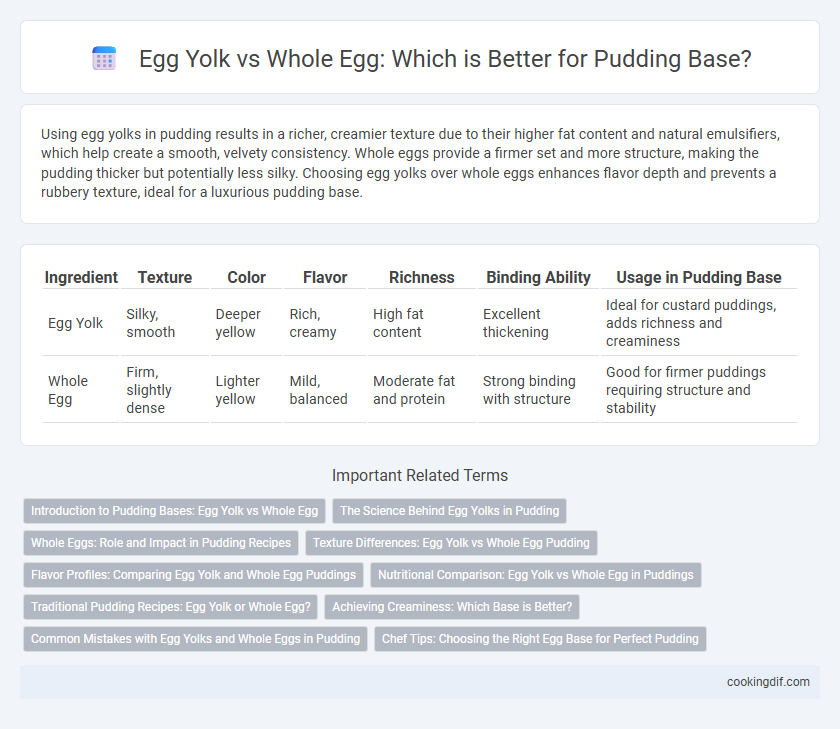Using egg yolks in pudding results in a richer, creamier texture due to their higher fat content and natural emulsifiers, which help create a smooth, velvety consistency. Whole eggs provide a firmer set and more structure, making the pudding thicker but potentially less silky. Choosing egg yolks over whole eggs enhances flavor depth and prevents a rubbery texture, ideal for a luxurious pudding base.
Table of Comparison
| Ingredient | Texture | Color | Flavor | Richness | Binding Ability | Usage in Pudding Base |
|---|---|---|---|---|---|---|
| Egg Yolk | Silky, smooth | Deeper yellow | Rich, creamy | High fat content | Excellent thickening | Ideal for custard puddings, adds richness and creaminess |
| Whole Egg | Firm, slightly dense | Lighter yellow | Mild, balanced | Moderate fat and protein | Strong binding with structure | Good for firmer puddings requiring structure and stability |
Introduction to Pudding Bases: Egg Yolk vs Whole Egg
Egg yolks create a rich, creamy pudding base due to their high fat content and emulsifying properties, resulting in a smooth, velvety texture. Whole eggs provide structure and stability by incorporating both the protein of egg whites and the fat of yolks, leading to a firmer, more set pudding. Choosing between egg yolks and whole eggs affects the pudding's consistency, richness, and cooking time, making it essential to match the base with the desired final texture.
The Science Behind Egg Yolks in Pudding
Egg yolks contain a high concentration of lecithin, a natural emulsifier that stabilizes the mixture and creates a smooth, creamy texture in pudding. The proteins and fats in yolks coagulate upon heating, thickening the custard-like base without curdling, which is essential for a rich consistency. Using whole eggs can result in a firmer pudding due to the additional egg whites, but may reduce the silkiness that pure yolks provide.
Whole Eggs: Role and Impact in Pudding Recipes
Whole eggs provide a balanced combination of proteins and fats that contribute to the smooth texture and rich flavor of pudding. The albumen in the egg whites helps thicken the mixture and stabilize the structure, while the yolks add creaminess and color. Using whole eggs results in a pudding with ideal consistency, improved emulsification, and a more cohesive mouthfeel compared to yolk-only bases.
Texture Differences: Egg Yolk vs Whole Egg Pudding
Egg yolk creates a richer, creamier pudding texture due to its higher fat content, resulting in a silkier mouthfeel and a more custard-like consistency. Whole eggs contribute both yolks and whites, producing a firmer pudding with a slightly firmer set and less smoothness compared to yolk-only bases. The proteins in egg whites provide structure and stability, making whole egg puddings more resilient to overheating but less velvety than those made exclusively with yolks.
Flavor Profiles: Comparing Egg Yolk and Whole Egg Puddings
Egg yolk-based puddings deliver a rich, creamy texture with a pronounced custard flavor, enhancing the dessert's smoothness and depth. Whole egg puddings provide a lighter texture and a more balanced taste due to the blend of egg whites, which adds structure without overpowering the dish. The choice between egg yolk and whole egg impacts the pudding's mouthfeel and flavor intensity, with yolk offering richness and whole egg contributing a subtler creaminess.
Nutritional Comparison: Egg Yolk vs Whole Egg in Puddings
Egg yolks provide a richer texture and higher fat content, contributing to creaminess and a velvety mouthfeel in puddings, while whole eggs offer a balanced profile of protein, fat, and moisture that supports structure and stability. Nutritionally, egg yolks are dense in vitamins A, D, E, and essential fatty acids, whereas whole eggs supply a complete set of amino acids along with additional protein and lower fat per serving. Selecting between egg yolks and whole eggs impacts the pudding's nutritional density, texture, and caloric content, crucial for tailored dietary preferences and culinary outcomes.
Traditional Pudding Recipes: Egg Yolk or Whole Egg?
Traditional pudding recipes often emphasize egg yolks for a richer, creamier texture due to their higher fat content and emulsifying properties. Whole eggs are used when a firmer, more custard-like consistency is desired, as the whites contribute structure through coagulation. Using egg yolks alone enhances smoothness and stability, making them ideal for classic vanilla or chocolate puddings.
Achieving Creaminess: Which Base is Better?
Egg yolks provide a rich, velvety texture to pudding due to their higher fat content and natural emulsifiers, making them superior for achieving creaminess. Whole eggs contribute a firmer structure and may result in a slightly less creamy consistency because of the egg whites' protein content. For a smooth, luscious pudding base, using egg yolks alone is typically preferred over whole eggs.
Common Mistakes with Egg Yolks and Whole Eggs in Pudding
Using only egg yolks in pudding often results in an overly rich and dense texture, while whole eggs can cause the pudding to become too firm or rubbery if overcooked. Common mistakes include not tempering eggs properly, leading to curdling, and overbeating whole eggs, which traps air and affects smoothness. Achieving the ideal pudding base requires balancing egg proportions and precise temperature control to avoid these texture issues.
Chef Tips: Choosing the Right Egg Base for Perfect Pudding
Egg yolks create a rich, creamy pudding base with a smooth texture due to their high fat content, making them ideal for custard-style desserts. Whole eggs provide a firmer structure and lighter texture, perfect for pudding recipes that require more stability or a fluffier consistency. Chefs recommend adjusting the yolk-to-white ratio according to desired creaminess and firmness to achieve the perfect pudding texture.
Egg yolk vs whole egg for pudding base Infographic

 cookingdif.com
cookingdif.com